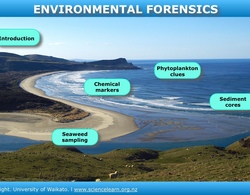Transcript
Dr Candida Savage
Trying to quantify and show direct linkages between land use and the ecological changes is really difficult, and that’s something that is probably the largest or the biggest challenge that we have to deal with. But there are certain key changes that we can look for, and we often rely on chemical signatures in these organisms, so we’ll look for particular chemical signatures or markers1 inside the seaweeds and the bivalves2 and in the fish. And we also have to back that up with experiments that we do in the laboratory setting. We've seen that, if we look at their gut content and if we look at chemical signatures that are carried in these fish, we see the fish that are occurring in the more pristine3 estuaries4 tend to have a much wider range of food sources that they can eat. The ones that are occurring in the more impacted areas tend to have a narrower group of organisms that they can eat.
Video: University of Waikato


